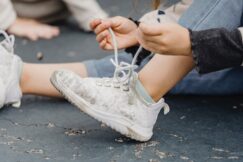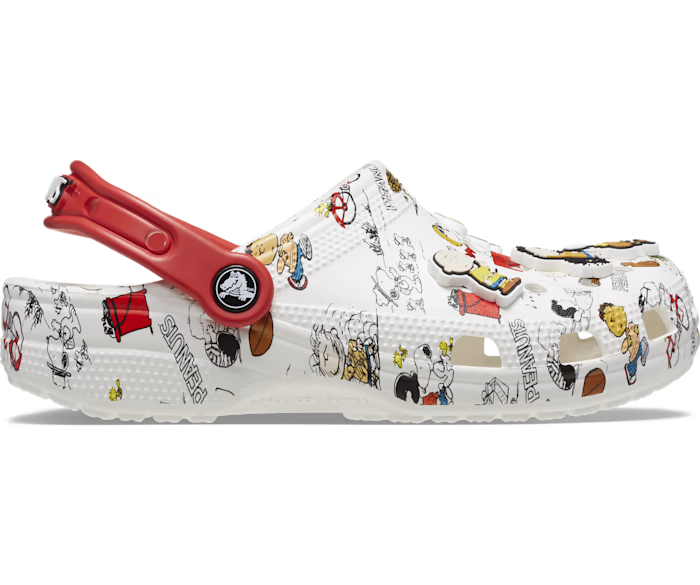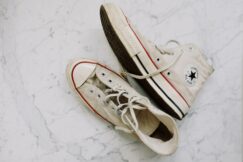How To Stop Shoes From Squeaking: 7 Simple Methods
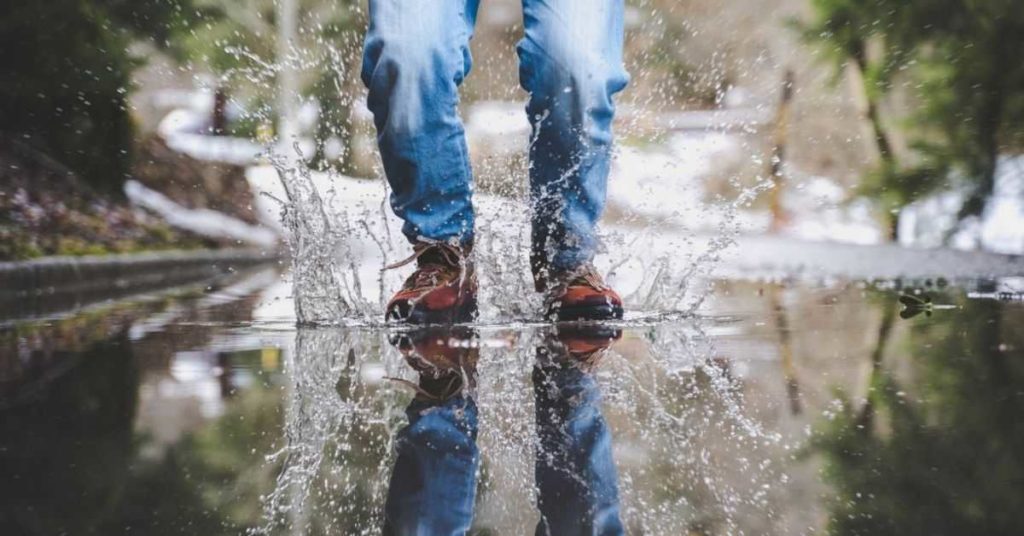
Imagine you walk into a library.
You make your way to the desk, and your shoes give out a screech.
You probably dismiss it as nothing, but you walk on to find the screeching won’t stop, and your unease builds with each step.
Everyone’s attention is on you and your shoes now.
You stand there, embarrassed and unsure how to respond, silently cursing your shoes in your head.
I’m sure you wouldn’t want a repeat of this situation, right?
Though you wonder how to stop shoes from squeaking?
Let me tell you; this can happen to anyone regardless of how new, old, or worn out their shoes are.
Plus, there are several reasons why shoes creak when you least expect it, or maybe you just don’t know how to fix squeaky shoes.
Luckily, there are plenty of ways to silence your squeaky shoes for good; and this is why I wrote this post.
I’ve had my share of creaking shoes, but I found a fix in time.
I’m sure there’ll be plenty of people out there who’d benefit from my advice that actually works. Let’s get into it!
What Are Squeaky Shoes?
Squeaky shoes happen when moisture or air bubbles collect inside the insoles or soles of shoes.
In most cases, rubber-soled or I’ve found canvas-lined shoes squeak a lot more, especially on wet and hard surfaces, because they’re naturally smooth and prone to squeaking on slick flooring.
Sometimes loose heels or outsoles are the culprits. And often, it is the shoe insert that makes all the noise when your feet rub against it.
Whatever the case, there are three major causes of squeaky shoes:
- Air
- Moisture
- Separation
Ironically, there is little difference between the causes and the solutions.
Lack of moisture, for example? Apply a lubricant! Too much moisture? Dry out your shoes. Loose, squeaky parts? Glue them back together.
Despite the simplicity of the process, these solutions for stopping shoes from squeaking are just a part of the story; there’s so much more you can do.
Here’s what you need to know!
What Else Could Be Causing Squeaky Shoes?
Aside from the three major causes above, it seems all squeaky problems lie at the bottom of the shoe, right?
Usually not!
According to wikiHow, some shoes squeak because the material on the outside rubs together or when the tongue rubs against the laces.
Sometimes, it’s our socks. Certain socks can cause sweat; hence the shoes can become squeaky from inside.
Furthermore, if you wear shoes with bare feet, especially on a hot day, your sweat could be causing all that noise.
If your shoes squeak, it could also be a sign they’re worn out, defective, or perhaps they’re still breaking in.
If you don’t know what’s breaking in, it’s the time your feet take to adjust to the shoes; it can take weeks or maybe a few days.
Either way, you must keep these causes in mind when you’ve just bought new shoes, and they’re squeaking already!
How Do You Fix Squeaky Shoes?

Now that we’ve covered the very reasons for squeaky shoes, let’s get to the nuts and bolts of stopping your shoes from squeaking.
Examining The Squeak
Isolate the source of the problem first: find out where the noise is coming from. To test your shoes, wear them and move them left, right, up, and down to find the squeaking location.
We recommend asking friends or kids to lie on the ground and detect where the squeaking sound is coming from when moving.
Once you catch the crook, it’s time to get to work.
The Bottom Squeaking
Suppose you hear a squeak from the bottom of your shoes. This may be due to the shoes being wet and causing the soles to screech..
The glue attaching the sole to the rest of the shoe may have come loose, causing trapped air to screech. Perhaps the bottom of the shoe is too slippery.
Or, if the soles of your shoes are rubber, they may have deteriorated (separated into two) or become wet, causing all the squeaking.
Solutions:
- Dry the shoes in the tumble dryer.
- Set the shoes out in the sun for a full day.
- You can make your shoes squeak less by rubbing the shoe bottom with a dryer sheet if the soles are too slick.
- You can roughen up the slippery and squeaky base by sanding it with sandpaper.
- It is also a good idea to rub the bottoms against a brick wall or sidewalk several times to make them less smooth and more grippy.
You can glue the shoe bottom or heel back onto the shoe if it has separated or there’s a gap. Use clamps to let the glue dry for 24 hours.
If you don’t have clamps, try tightly wrapping the shoes with a cloth, or use rubber bands to secure the bottom and the rest of the shoe together until the glue dries.
The Insides Squeaking
If the squeaking is coming from the inside of your shoes, your sweat from your bare feet might be causing the sound, or the tongue could be causing friction within the shoe from too much movement.
There are several simple hacks to fix this problem.
The Powder Fix

When you pull out the insoles, sprinkle baby powder or cornstarch inside the shoe. Feel the damp interior with your hand and make sure that the powder is evenly distributed.
Tap off any excess powder if you don’t want clouds of powder to come out when you wear your shoes.
The powder will absorb all the moisture. Place the insoles back, and the squeaking should be less noticeable.
If your shoes do not have removable insoles, sprinkle the powder along the seams and gently shake your shoes to spread them.
The Paper Towel Fix
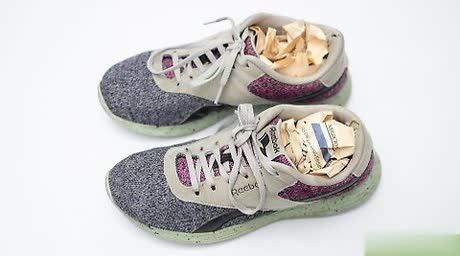
To prevent squeaking and excessive movement of the insoles, use paper towels, dryer sheets, or paper napkins under them.
In order to avoid a foul odor, you should repeat this step after you’ve worn the shoes a few times.
Be sure the paper towels are folded small enough to fit inside, without sticking out from the sides.
The Lubricant Fix

Using lubricant is another helpful tip. Take out the insoles and apply a small amount of coconut oil to the entire area.
Place the insoles back, and the squeaking should stop.
Sometimes rubbing vaseline or hand lotion will do the trick, or you can use WD-40, a water-resistant silicone lubricant, for a more well-done and professional touch.
The Socks Fix
Wear your shoes with soft wool socks or white, no-show socks, or sweat-wicking footlet to reduce friction. Keep an extra pair of socks to change in case the squeaking returns.
Avoid cotton socks and choose socks with breathable, good-quality fabric. Merino wool or bamboo fiber socks are an excellent place to start.
The Sandpaper Fix
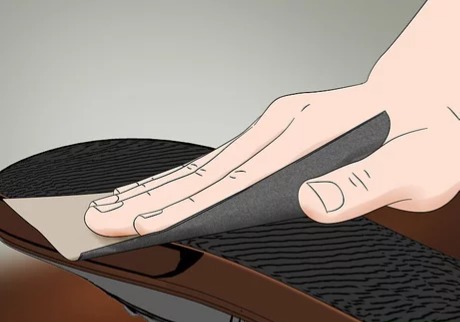
Use some fine-grit sandpaper and smooth out the tongue and its edges which rub against the sides of the shoe with the paper. It will minimize squeaking.
If sanding the tongue is not for you, you can wrap fabric or athletic tape around the insert’s edges. This will prevent the insert from shifting too much inside the shoe. It should reduce the squeaking of shoes.
If nothing works, replace the old insoles with new ones.
The Outside Squeaking
Squeaking from the outside of the shoes can occur for many reasons.
There’s a chance that the shoe is wet, the laces, eyelets, and accessories (like a buckle) are rusty, and the shoe needs polishing. Perhaps the shoes have grown too tight or are simply too worn out.
You can follow the solutions below if any of these circumstances apply to you.
Dry Out In The Sun
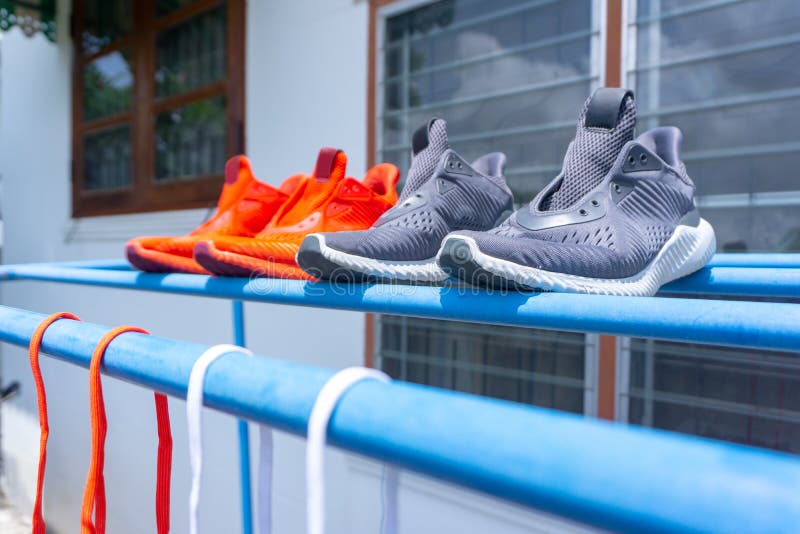
I’d recommend “drying out in the sun” as a starting place for everyone with any squeaky shoe. Always make sure your shoes are dry to check if that improves the squeaking noise before trying the other methods.
- You can place the shoes near a window or hang them to dry in a warm place like the laundry room or sunroom, near a fireplace or heater.
- Newspaper stuffed in shoes will absorb extra moisture. You should leave the newspaper-filled shoes somewhere in a warm and dry place overnight. Essentially, this is going to stop the squeaking.
Apply A Conditioning Oil
A dry or rusty shoe exterior can rub together to cause squeaking. By applying a conditioning lubricant to the outside of the shoes, you can restore moisture to the shoes and make them less likely to squeak.
- Soften the outer parts of the shoes by applying the conditioning oil with a soft cloth. Don’t forget to lubricate the shoes in gentle, circular motions.
- You should only use a conditioning oil that is suitable for the fabric of your shoes. If you want to condition leather, for example, use leather conditioning oil.
- The conditioning oil will wear away over time. If squeaking returns, carry out this procedure again.
Use A Saddle Soap Or Candle Wax
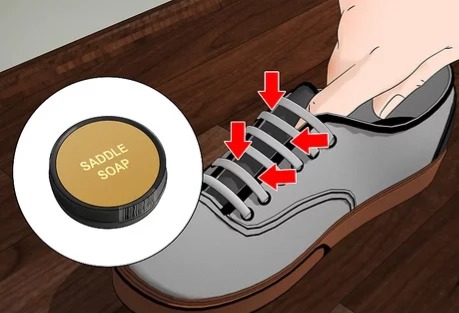
If the tongue is squeaking, it’s probably because the laces are rusty and rubbing against each other. Laces can sometimes be tied extra tight to prevent squeaking. However, if that doesn’t work, the lace area may need moisture.
- Saddle soap works like a conditioner for shoes. Applying it to the front of the tongue, the edges, and the eyelets adds necessary moisture and may resolve the squeaking issue.
- Like conditioning oil, it wears off over time. You need to apply this soap again to your squeaky footwear.
- If your shoes have noisy buckles, do the same to them. Lubricate them with candle wax, conditioning oil, or saddle soap to prevent them from squeaking.
How To Stop Shoes From Squeaking On Linoleum?
You will typically find linoleum floors in most workplaces, which can cause squeaking from your shoes and can be quite annoying to you and other people.
The reasons for this are exactly what we discussed above, so we’ll share how to stop shoes from squeaking on linoleum instead.
These tips are also ideal if you don’t know how to stop shoes from squeaking on hard floors.
Several of the shoe bottom solutions covered above can prevent squeaky shoes on linoleum or hard floors. However, there are a few other things we would like to mention.
New Shoes Squeaking
If your shoes are new and very comfortable but squeak, it may be that the bottom lacks traction needed for hard floors, and that is why they squeak.
- You can break in your shoes by walking in them, allowing the bottom to get scrubbed up, which improves traction and noise.
- Check your outsole for debris and stones that may be causing the squeaking and manually clean it.
- Spraying hairspray on the bottom of the shoes will provide traction and eliminate the noises. If your shoes have rubber soles, WD-40 (works on other outsoles as well) or rubber sole spray on the bottom can work wonders to lessen squeaks.
It’s possible if nothing works that it is not your fault, but the shoes are defective.
If you plan to return the shoes, then avoid these DIY methods because it may risk the warranty, and you will be unable to return, exchange, refund, or have them repaired.
Old Shoes Squeaking
We can all agree that quality fades away with time. Shoes are no different.
I understand, we often are sensitive towards a pair we love; we develop an emotional connection with things that work for us time and time again.
Nonetheless, materialistic things have an expiry date, and if your old shoes start squeaking, then it could be a warning bell that you need a new pair.
In most cases, the outsole may have split, developed air bubbles or the heel is too worn out and coming off.
The Heel Fix
However, if you simply cannot replace your old shoes because they’re very comfortable, you paid a big sum for them, and obviously, they’re your favorite, then you might need to follow some of our methods in the “shoe bottom” section above.
If it’s a loose heel causing the squeaking on a linoleum floor, you need to use superglue to reattach the heel and let it dry for 24 hours till the heel doesn’t move from its place.
If your heels are worn to a frazzle, and you’re wondering how to stop shoes from squeaking on linoleum, visiting a cobbler might be helpful.
Call In A Professional
A little superglue may fix the squeaking for a short period.
But shoes that are too worn down for their own good and the squeaking is more of a structural issue; it might not be worth all your DIY fixes: You should call in a professional.
Visiting a cobbler would be more appropriate, given the situation. They could resole your shoes if you think they still have a chance. Repairing everything yourself is a huge and complicated task.
These tips hold the same value if you’re looking to seek answers on how to stop shoes from squeaking on hard floors.
How to stop leather shoes from squeaking?
Leather shoes demand special attention, and if they aren’t cared for when their maintenance is due, some serious complications can occur, like squeaking, for instance.
Squeaking in leather shoes could mean many things: dry leather, rust, worn-out body, and trapped moisture.
Don’t worry if you don’t know how to stop leather shoes from squeaking; I have made it easy for you by sharing my leather care routine with you.
Check For Moisture
Insoles may contain moisture trapped inside them.
Likewise, apply talcum powder just as described above. Put some powder beneath the insoles to absorb excess moisture, remove the excess powder, and place the insoles back in.
This should help put off the squeaking.
Check The Heels
The heels of leather shoes can wear out and come loose at any time.
Consequently, air pockets form in the gap between the heel and shoe body, causing squeaks when you walk. It is possible to reattach heels with superglue, but if that sounds too challenging, you can have a cobbler replace the heels.
Condition The Leather
Well-maintained leather shoes are well-conditioned. In this case, use mink oil or leather conditioner oil.
Be sure to get the lubricant into the nooks and crannies of the outer parts of the shoe. Make sure that the leather products you use do not cause discoloration.
Follow Regular Maintenance
Dry leather shoes indicate that they need to be cleaned, conditioned, and polished. Regular maintenance keeps them in fantastic condition and prevents cracking and squeaking to a great degree.
Frequently Asked Questions
Why do my shoes squeak every time I walk?
Your shoes squeak for a variety of reasons. The leading causes are either the bottoms are too slick, especially leather bottoms, there’s water damage, too much loose foot motion, or trapped air inside the body.
Our article brings forward solutions to these problems. Still, as a quick fix, I recommend always selecting the correct shoe size, drying out your shoes properly, and following regular shoe maintenance, depending on the fabric and material of the shoes.
How do I stop my shoes from squeaking when I walk?
Our article is a great starting point if you want to learn how to stop shoes from squeaking when you walk. Determine which part of the shoe is squeaking. If it’s outside, use conditioning oil on the outer parts of your shoes.
Using a cement spray on the bottom front of your shoes gives them traction for reduced friction if it is the bottom creating the noise. Sanding the base of the shoe with fine sandpaper might also help.
If it’s on the inside, replace the insert, then use baby powder to dry off any excess moisture. You should also refrain from wearing socks that encourage excessive sweating or wearing shoes with bare feet. And your shoes will stop squeaking as much.
How do you get shoes to stop squeaking?
Several factors contribute to squeaking shoes. The shoes might be too worn, wet, the bottom has a gap, the heel is coming off, or the insoles are moving too much. Considering all of these factors, you need to pick the right procedure, and for that, you can read our article on how to stop shoes from squeaking.
To summarize, you should dry your shoes first. If that doesn’t solve the problem, figure out the source of the noise and follow the instructions we have provided in our post.
Does WD-40 stop shoes from squeaking?
Yes, WD-40 really works to keep shoes from squeaking. Put some WD-40 on a cotton ball and gently work the product into the outer parts of your shoes. It will soften and lubricate the exterior to reduce rust and friction-based squeaking noises. If the squeaking is coming from the inside, spray WD-40 underneath the removable insoles to hold them better in place and lubricate that area.
Conclusion
Squeaky shoes are embarrassing when they make your presence known before you do.
It’s not just annoying to you but also to those around you.
That realization can be emotionally draining, especially if the noise comes from your favorite pair of shoes.
However, before people point out the obvious, our in-depth guide on how to stop shoes from squeaking solves the root cause of this issue.
If your shoes squeak more when walking or on linoleum and hard floors, we take you through a step-by-step process to answer all your burning questions so you can become your own DIY master.
There’ll be no need to chuck your shoes then! If you think you have better recommendations to fix squeaky shoes, let us know in the comments below.
Your valuable feedback means a lot to us and helps us create content you love to read.
